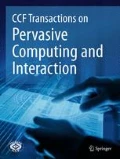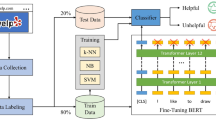Abstract
Reviews contain rich information of user interests and item characteristics. Incorporating reviews into recommendation has attracted increasing attention in recent years, which can help learn more accurate user and item representations for recommendation. Existing review based recommendation methods usually utilize the content of reviews while ignoring the helpfulness scores associated with them. Since different reviews have different informativeness and many reviews are noisy and even misleading, incorporating the helpfulness information of reviews can help better exploit the reviews for recommendation. In this paper, we propose a helpfulness-aware review based recommendation approach. The core of our approach is a review encoder and a user/item encoder. In the review encoder we learn representations of reviews from their content in a hierarchical way. We first learn sentence representations from words and then learn review representations from sentences, using a hierarchical attention network to select important words and sentences. In the user/item encoder, we learn representations of users/items from their reviews using an attention network. The query vector of the attention network comes from the helpfulness scores of these reviews. Since many reviews do not have helpfulness scores, we propose a neural helpfulness prediction model to predict the helpfulness scores of these reviews. The neural helpfulness prediction model is trained on the limited reviews with helpfulness scores voted by users. Extensive experiments on four benchmark datasets show that incorporating the helpfulness of reviews can effectively improve the performances of review based neural recommendation methods.









Similar content being viewed by others
References
Almahairi, A., Kastner, K., Cho, K., Courville, A.: Learning distributed representations from reviews for collaborative filtering. In: RecSys, pp. 147–154 (2015)
Bao, Y., Fang, H., Zhang, J.: Topicmf: Simultaneously exploiting ratings and reviews for recommendation. In: AAAI (2014)
Bell, R., Koren, Y., Volinsky, C.: Modeling relationships at multiple scales to improve accuracy of large recommender systems. In: KDD, pp. 95–104 (2007)
Bhatt, A., Patel, A., Chheda, H., Gawande, K.: Amazon review classification and sentiment analysis. Int. J. Comput. Sci. Inf. Technol. 6(6), 5107–5110 (2015)
Catherine, R., Cohen, W.: Transnets: Learning to transform for recommendation. In: RecSys, pp. 288–296 (2017)
Chen, C., Qiu, M., Yang, Y., Zhou, J., Huang, J., Li, X., Bao, F.: Review helpfulness prediction with embedding-gated cnn. arXiv preprint arXiv:1808.09896 (2018)
Chen, C., Yang, Y., Zhou, J., Li, X., Bao, F.S.: Cross-domain review helpfulness prediction based on convolutional neural networks with auxiliary domain discriminators. In: NAACL, pp. 602–607 (2018)
Chen, C., Zhang, M., Liu, Y., Ma, S.: Neural attentional rating regression with review-level explanations. In: WWW, pp. 1583–1592 (2018)
Cheng, P., Wang, S., Ma, J., Sun, J., Xiong, H.: Learning to recommend accurate and diverse items. In: WWW, pp. 183–192 (2017)
Conneau, A., Schwenk, H., Barrault, L., Lecun, Y.: Very deep convolutional networks for text classification. arXiv preprint arXiv:1606.01781 (2016)
Glorot, X., Bordes, A., Bengio, Y.: Deep sparse rectifier neural networks. In: AISTATS, pp. 315–323 (2011)
He, X., Chen, T., Kan, M.Y., Chen, X.: Trirank: Review-aware explainable recommendation by modeling aspects. In: CIKM, pp. 1661–1670 (2015)
Kim, D., Park, C., Oh, J., Lee, S., Yu, H.: Convolutional matrix factorization for document context-aware recommendation. In: RecSys, pp. 233–240 (2016)
Kim, S.M., Pantel, P., Chklovski, T., Pennacchiotti, M.: Automatically assessing review helpfulness. In: EMNLP, pp. 423–430 (2006)
Kim, Y.: Convolutional neural networks for sentence classification. arXiv preprint arXiv:1408.5882 (2014)
Kingma, D.P., Ba, J.: Adam: A method for stochastic optimization. arXiv preprint arXiv:1412.6980 (2014)
Koren, Y.: Factorization meets the neighborhood: a multifaceted collaborative filtering model. In: KDD, pp. 426–434 (2008)
Koren, Y., Bell, R., Volinsky, C.: Matrix factorization techniques for recommender systems. Computer 8, 30–37 (2009)
Krishnamoorthy, S.: Linguistic features for review helpfulness prediction. Expert Syst. Appl. 42(7), 3751–3759 (2015)
Le, H.T., Cerisara, C., Denis, A.: Do convolutional networks need to be deep for text classification? In: AAAI (2018)
Lee, D.D., Seung, H.S.: Algorithms for non-negative matrix factorization. In: NIPS, pp. 556–562 (2001)
Ling, G., Lyu, M.R., King, I.: Ratings meet reviews, a combined approach to recommend. In: RecSys, pp. 105–112 (2014)
Liu, P., Qiu, X., Huang, X.: Adversarial multi-task learning for text classification. arXiv preprint arXiv:1704.05742 (2017)
Liu, Y., Huang, X., An, A., Yu, X.: Modeling and predicting the helpfulness of online reviews. In: ICDM, pp. 443–452 (2008)
Luo, X., Zhou, M., Li, S., You, Z., Xia, Y., Zhu, Q.: A nonnegative latent factor model for large-scale sparse matrices in recommender systems via alternating direction method. TNNLS 27(3), 579–592 (2015)
McAuley, J., Leskovec, J.: Hidden factors and hidden topics: understanding rating dimensions with review text. In: RecSys, pp. 165–172 (2013)
Mikolov, T., Sutskever, I., Chen, K., Corrado, G.S., Dean, J.: Distributed representations of words and phrases and their compositionality. In: NIPS, pp. 3111–3119 (2013)
Mnih, A., Salakhutdinov, R.R.: Probabilistic matrix factorization. In: NIPS, pp. 1257–1264 (2008)
Mudambi, S.M., Schuff, D.: What makes a helpful review? A study of customer reviews on amazon. com. MIS Q. 34(1), 185–200 (2010)
Ngo-Ye, T.L., Sinha, A.P.: The influence of reviewer engagement characteristics on online review helpfulness: a text regression model. Decis. Support Syst. 61, 47–58 (2014)
Park, S.T., Chu, W.: Pairwise preference regression for cold-start recommendation. In: Proceedings of the third ACM conference on recommender systems, pp. 21–28. ACM (2009)
Qazi, A., Syed, K.B.S., Raj, R.G., Cambria, E., Tahir, M., Alghazzawi, D.: A concept-level approach to the analysis of online review helpfulness. Comput. Hum. Behav. 58, 75–81 (2016)
Seo, S., Huang, J., Yang, H., Liu, Y.: Interpretable convolutional neural networks with dual local and global attention for review rating prediction. In: RecSys, pp. 297–305 (2017)
Seo, S., Huang, J., Yang, H., Liu, Y.: Representation learning of users and items for review rating prediction using attention-based convolutional neural network. In: MLRec (2017)
Singh, J.P., Irani, S., Rana, N.P., Dwivedi, Y.K., Saumya, S., Roy, P.K.: Predicting the “helpfulness” of online consumer reviews. J. Bus. Res. 70, 346–355 (2017)
Srivastava, N., Hinton, G., Krizhevsky, A., Sutskever, I., Salakhutdinov, R.: Dropout: a simple way to prevent neural networks from overfitting. J. Mach. Learn. Res. 15(1), 1929–1958 (2014)
Tan, Y., Zhang, M., Liu, Y., Ma, S.: Rating-boosted latent topics: Understanding users and items with ratings and reviews. IJCAI 16, 2640–2646 (2016)
Tang, J., Gao, H., Hu, X., Liu, H.: Context-aware review helpfulness rating prediction. In: RecSys, pp. 1–8 (2013)
Tay, Y., Luu, A.T., Hui, S.C.: Multi-pointer co-attention networks for recommendation. In: KDD, pp. 2309–2318 (2018)
Yang, Z., Yang, D., Dyer, C., He, X., Smola, A., Hovy, E.: Hierarchical attention networks for document classification. In: ACL, pp. 1480–1489 (2016)
Zhang, X., Zhao, J., LeCun, Y.: Character-level convolutional networks for text classification. In: Advances in neural information processing systems, pp. 649–657 (2015)
Zheng, L., Noroozi, V., Yu, P.S.: Joint deep modeling of users and items using reviews for recommendation. In: WSDM, pp. 425–434 (2017)
Zhou, K., Yang, S.H., Zha, H.: Functional matrix factorizations for cold-start recommendation. In: SIGIR, pp. 315–324 (2011)
Author information
Authors and Affiliations
Corresponding author
Rights and permissions
About this article
Cite this article
Ge, S., Qi, T., Wu, C. et al. Helpfulness-aware review based neural recommendation. CCF Trans. Pervasive Comp. Interact. 1, 285–295 (2019). https://doi.org/10.1007/s42486-019-00023-0
Received:
Accepted:
Published:
Issue Date:
DOI: https://doi.org/10.1007/s42486-019-00023-0




